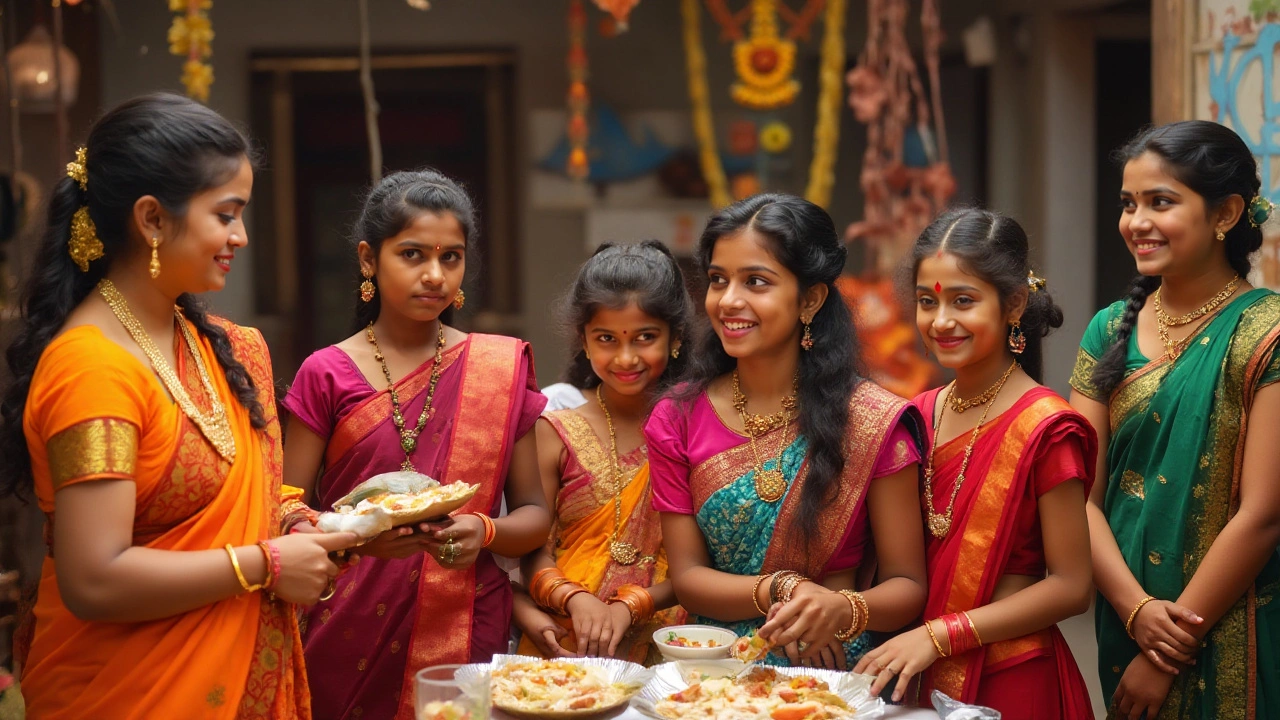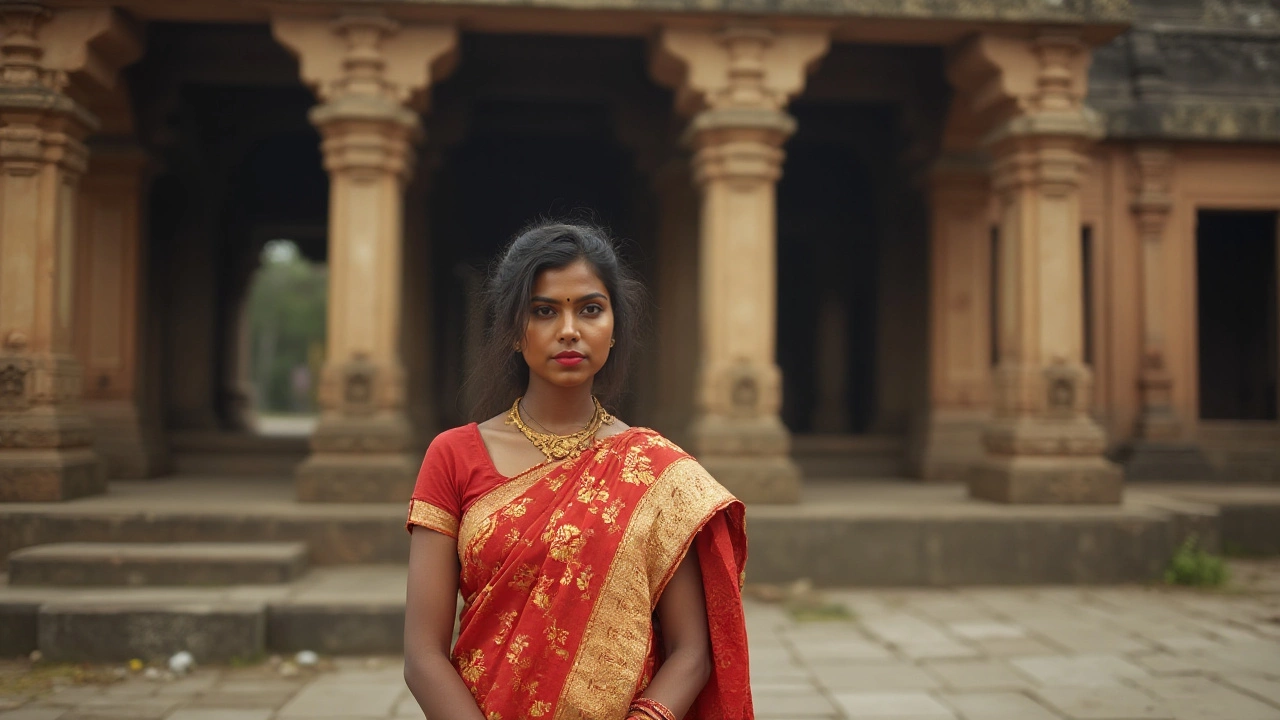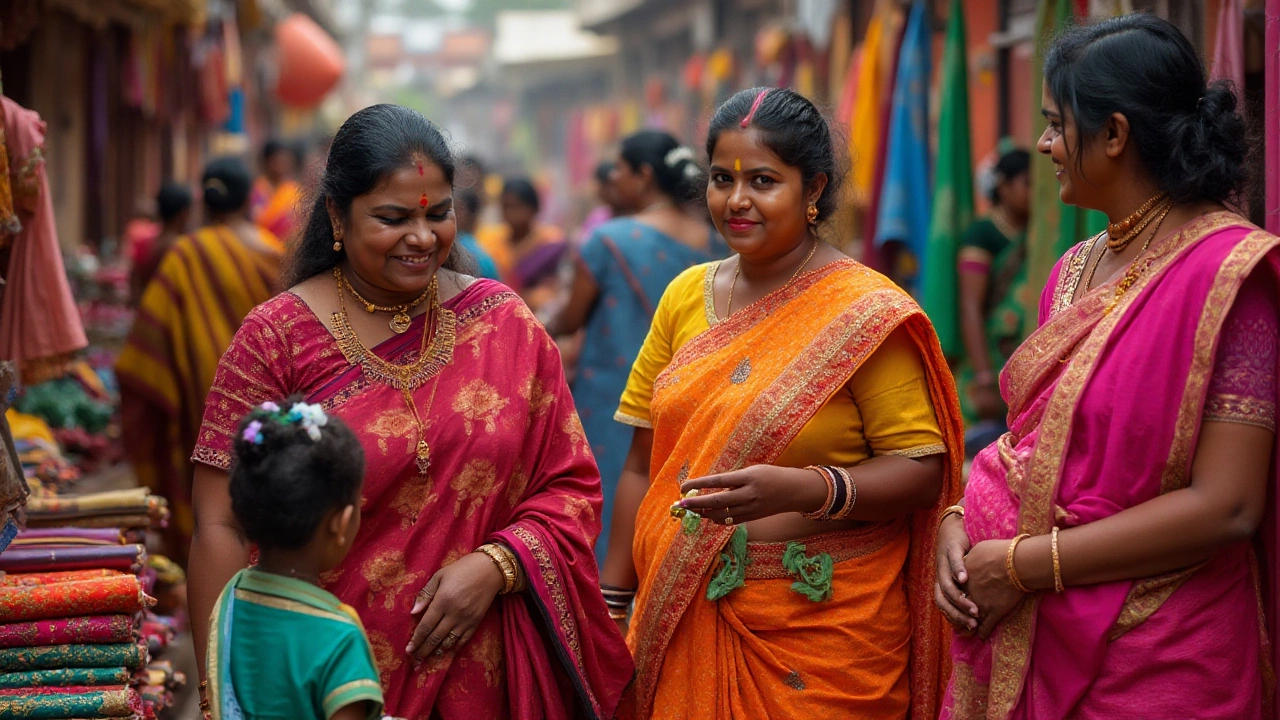Tamil Nadu, a state known for its rich cultural heritage and traditions, showcases a unique dress code for women that beautifully combines tradition with elegance. The clothing styles here are not merely about fashion; they tell a story of the region's history, social customs, and artistic endeavors.
Women typically adorn themselves in sarees and half-sarees, which vary in style, fabric, and draping techniques depending on the occasion and region within Tamil Nadu. These garments, adorned with vibrant colors and intricate designs, hold cultural significance and are a testament to the meticulous craftsmanship passed down through generations.
Exploring the traditional dress code in Tamil Nadu provides an insightful perspective into the everyday lives, festivities, and rituals of its people, helping us appreciate the deeper meanings woven into the fabric of this vibrant culture.
- Historical Background
- Traditional Attire Types
- Cultural Significance
- Regional Variations
- Modern Adaptations
Historical Background
The dress code of Tamil Nadu, especially for women, has a lineage that traces back thousands of years, coinciding with the rich tapestry of the state's cultural heritage. Historically, clothing in this region has been influenced by many factors ranging from geography to trade interactions. Of particular interest is how traditional attire such as the saree developed as a versatile garment suited to the tropical climate, providing both comfort and elegance. The ancient Dravidian civilization, with its sophisticated urban settlements, reflected their advanced textiles in historical records and sculptures, which exhibit depictions of elaborate drapery and intricate ornamentation.
During the Sangam period, which is considered a golden age in Tamil history, literature and poems described the sartorial choices of the people, particularly women who were often bedecked in gold, precious gems, and colorful silk and cotton drapes. These early accounts highlight the importance of clothing not just as a utility but as an emblem of identity, creativity, and status. As trade with distant lands flourished, new fabrics like silk were introduced by maritime merchants, enhancing the variety and quality of textiles available to the Tamil people.
An essential chapter in the historical narrative is how Tamil Nadu became a key hub for textile production during the medieval ages, fostering a flourishing industry that maintains its significance even today. Under the Chola and Pandya dynasties, the attire became more elaborate and detailed, with advancements in dyeing and weaving techniques giving birth to styles unique to each ruling era. In fact, epigraphs and sculptures from temples built during these periods offer a vivid glimpse into the prevailing fashion trends, immortalizing them in stone reliefs.
The influence of colonial rule also brought about changes in the dressing habits of Tamilians, blending local traditions with new European trends, yet the traditional styles steadfastly endured. Esteemed historian James Heitzman, in his extensive studies on South Indian cultures, noted,
"The resilience of Tamil clothing traditions against the tides of foreign influence is a testament to the people's deep-rooted connection to their cultural heritage."Thus, maintaining the essence of Tamil Nadu's unique dress code through periods of great historical upheaval.
Traditional Attire Types
The vibrant culture of Tamil Nadu is literally woven into the fabric of its traditional attire for women, which is a grand tapestry of history and elegance. The most iconic piece of clothing associated with the region is the saree, with its roots deeply embedded in tradition. Sarees in Tamil Nadu are a six to nine-yard yard fabric that requires skillful draping, making it not only a garment but an art form. They are crafted from a myriad of fabrics including silk, cotton, and synthetic blends, each offering a different drape and feel. The Kanchipuram silk saree is particularly renowned for its opulent and elaborate designs, and it serves as the quintessential choice for auspicious occasions and festivals. These sarees are often woven with rich motifs and borders that tell tales of mythological epics, making each piece a narrative in itself.
Another essential traditional attire is the pavada davani, also known as half-saree, typically worn by young girls during their transition from adolescence to adulthood. It's a three-piece attire consisting of a skirt, blouse, and a scarf, elegantly draped over the shoulder. The half-saree allows young girls a chance to embrace traditional dressing while preparing them for the intricacies of draping a full saree in due course. Rich silk and cotton variants of the pavada davani are common, especially for festive events and family gatherings.
Cultural historian Ramanathan Subramanian once noted, "The pavada davani is more than just a rite of passage; it's a celebration of youthful exuberance, embodied in color and fabric."
The Tamil Nadu dress code is not limited to these iconic garments alone. The madisar is a distinctive nine-yard saree drape worn by women of the Iyer and Iyengar communities during specific rituals and celebrations. This draping style is unique compared to the regular saree, emphasizing tradition and religious adherence. Another intriguing aspect is the variety of regional styles within Tamil Nadu. In Chettinad, the sarees are shorter in length, and their bold, contrasting colors reflect the community’s vibrant spirit. Beyond festive attire, daily wear options include the simple, yet elegant cotton sarees and salwar kameez, offering practicality without compromising on tradition. For those seeking a visual spectacle, temple festivals often showcase the traditional attire of rural Tamil Nadu women, with their graceful sari drapes and ornate jewelry glittering in the sun. Such occasions are ideal for observing the cultural diversity embodied through clothing, proving that attire is indeed a living expression of Tamil Nadu's enduring traditions.

Cultural Significance
The traditional costumes of Tamil Nadu, especially for women, are much more than garments—they are cultural symbols steeped in history and meaning. The saree, often worn by older girls and women, serves as a canvas that depicts the legacy of Tamil Nadu's rich art and cultural expressions. It is not just a piece of fabric but a representation of the region's identity, varying from one community to another, carrying tales of ancestry, tradition, and craftsmanship.
A striking feature of these Tamil Nadu dress code traditions is the diversity seen in saree styles across various communities and regions. For instance, the Kanchipuram silk sarees are famous for their durability and grandeur, often being a staple in weddings and major festivals. The way these sarees are crafted involves a painstaking process that showcases skilled artistry, where each motif holds its historical importance and story. The vibrant colors and bold patterns symbolize prosperity and joy, reflecting the vivacity of Tamil culture.
The half-saree, typically worn by younger girls, marks a transitional garment signifying the step from childhood to womanhood. This attire is not merely a piece of clothing; it represents a rite of passage. As girls adorn themselves with this outfit during ceremonies, it becomes a powerful visual narrative of growth and celebration. The half-saree also contributes to social cohesion, often involving group dances where clothing uniformity underpins unity and shared cultural values.
Cultural significance is also evident in the traditional attire types worn during specific cultural and religious festivities. Clothing becomes an identifier, resonating with the spiritual and earthly attributes of the event. Each thread woven into these garments not just reflects the skill but also the myriad cultural influences India's southern region has imbibed over centuries. The draping styles differ in festivals, highlighting how Tamil attire evolves with cultural flux.
Influence of Religion and Social Norms
Religious beliefs deeply influence women's clothing in Tamil Nadu. Traditional attire often represents the wearer's devotion and reflects a respect for social norms. During festivals like Pongal, women commonly wear brightly colored sarees as part of the joyous celebration, intertwining the religious sentiment with regional dress codes. Even the choice of jewelry that complements these outfits has spiritual relevance, believed to bring prosperity and protect against negative energies.
"In clothing, as with music or speech, we find a compelling narrative of human character and history," says renowned cultural historian R. Nagaswamy, capturing the essence of traditional attire.
Throughout Tamil Nadu, the dress code also encompasses the profound respect for nature and community. With roots pinned in agrarian society, the colors and materials often reflect natural elements, underscoring sustainable practices that have been honored across generations. Social interactions often revolve around shared customs, where clothing acts as a badge of cultural continuity and shared heritage.
The role of traditional attire in Tamil Nadu is a testament to community life, often safeguarding cultural values amidst the ever-changing modern landscape. It fosters identity and pride and acts as a bridge, connecting the past with the present and future aspirations of the Tamil community. Each thread in the garment thus supports the weight of shared stories, echoing the vibrant spirit of Tamil Nadu.
Regional Variations
The traditional attire of women in Tamil Nadu is as diverse as the state itself. Each region within Tamil Nadu has its own unique style that reflects its local culture, climate, and historical influences. In the southern districts, for instance, the sarees are typically vibrant, with bold colors and mirror work that catch the sunlight in striking ways. These garments are often crafted from cotton or silk, designed to keep the wearer cool in the humid climate.
Moving northward, closer to Chennai, the sarees become more understated but elegant, often featuring subtle motifs and patterns that may speak to the city's cosmopolitan culture. In these regions, you might find the occasional fusion of traditional and modern, where young women pair sarees with contemporary blouses or accessories, a nod to Tamil Nadu's dynamic blend of tradition and modernity.
The region of Kanchipuram is world-renowned for its silk sarees, known as Kanchipuram sarees. These are characterized by their intricate designs, rich colors, and the distinctive pallu or end-piece. The sarees from this region are often embroidered with gold thread, making them a popular choice for festivals and weddings. As an interesting fact, it can take anywhere from 10 to 30 days to create a single Kanchipuram saree, depending on its complexity. Tamil Nadu dress code is intricately linked with these regional variations, showcasing the state's artistic diversity.
The Kanchipuram silk sarees are described by Garima Gupta, a noted fashion historian, who once said, 'Owning a Kanchipuram saree is not just about wearing a piece of clothing. It’s about carrying a legacy that weaves both people and the past together.'
In regions with distinct ethnic groups, such as Chettinad, the attire typically includes heavier fabrics suitable for ceremonial occasions. Chettinad sarees, known for their bold stripes and checks, are crafted using handwoven cotton, making them suitable for the hot climate and daily wear. These sarees are often complemented with distinctive jewelry styles unique to the Chettinad culture, showcasing the deep connection between clothing and local artistry.
A study of Tamil Nadu’s garments wouldn't be complete without mentioning the half-saree or pavada thavani, prevalent among younger girls, especially in rural areas. This dress consists of a full-length skirt (pavada), a blouse (thavani), and a drape over the blouse, reflecting a traditional style that is less restrictive and easier to manage for daily activities. Many schools encourage this traditional attire for cultural days or festivities, keeping the young generation connected to their roots.
Across Tamil Nadu, Tamil culture dictates attire according to the event and locality, with adaptations that reflect both timeless traditions and evolving trends. This blend of local preferences and cultural heritage defines the timeless fashion that continues to inspire designers and wearers, both within the state and globally.

Modern Adaptations
The world of fashion is ever-evolving, and the traditional dress code for women in Tamil Nadu is no exception to these changes. While sarees and half-sarees remain an important part of the cultural identity, there's a noticeable shift towards more contemporary styles that blend traditional and modern elements. This fusion is particularly evident among the younger generations and urban Tamil Nadu, where cultural heritage meets modern comfort and practicality, resulting in unique styles that still pay homage to their roots.
One of the most interesting trends is the increased use of contemporary fabrics in traditional garments. Materials like georgette, chiffon, and crepe are becoming popular in everyday wear and special occasions, replacing the heavier silks traditionally reserved for festive events or weddings. These lighter fabrics offer ease of movement, making them well-suited to the demands of modern life. This adaptation is not only stylish but also practical for the warm and humid climate of Tamil Nadu.
Fashion designers actively embrace traditional embroidery and design techniques like zari and resham, incorporating them into modern silhouettes. The result is a wide range of semi-traditional attire that appeals to women who wish to honor their cultural heritage without compromising on contemporary aesthetics. It's common now to see fusion wear combining kurtas with jeans or pairing traditional blouses with modern skirts, creating a fresh look that remains deeply connected to the Tamil culture.
The adaptation is also evident in the incorporation of Western styles. Ready-to-wear sarees, designed to be more accessible and easy to drape, have become a staple for those who appreciate traditional attire but seek the convenience of modern clothing. These ready-to-wear options are popular among working women and college students who balance a busy schedule but still wish to maintain their cultural identity. A recent survey highlighted that nearly 60% of young women in urban Tamil Nadu own at least one ready-to-wear saree.
"The fusion of traditional and modern elements in Tamil Nadu's fashion scene represents not just change, but an embrace of a wider range of influences. It's about cultural conversations," says a renowned Chennai-based fashion designer.Digital platforms have also played a role in promoting these modern adaptations, with social media influencers often showcasing how conventional wardrobe pieces can be stylishly integrated into everyday fashion. This exposure has sparked a renewed interest in traditional attire among younger demographics who are keen on exploring their roots in a format that resonates with their current lifestyle.
In educational institutions, this blend of traditional and modern attire is visible, where girls often pair traditional half-sarees with trendy tops and accessories, reflecting their personal style while adhering to societal norms. As a result, there is an ever-expanding marketplace for such hybrid styles in Tamil Nadu, which caters to a growing demand for culturally resonant yet contemporary fashion solutions. Tables showcasing comparisons of traditional versus modern fabric costs also indicate a gradual move towards these lighter, more affordable materials among consumers.
